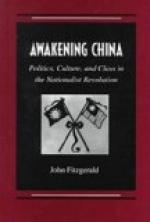[Page 45] CHAPTER IX
THE RIVER PROVINCES
Hupeh—Hankow—Hanyang Iron Works—A Centre of Missionary Activity—Hunan—Kiangsi—Anhwei—Native Province of Li Hung Chang
By the term “river provinces” are to be understood those provinces of central and western China which are made accessible to intercourse and trade by means of the Yang-tse Kiang.
Pursuing our journey, in twelve hours by rail we reach the frontier of Hupeh. At that point we see above us a fortification perched on the side of a lofty hill which stands beyond the line. At a height more than double that of this crenelated wall is a summer resort of foreigners from Hankow and other parts of the interior. I visited this place in 1905. In Chinese, the plateau on which it stands is called, from a projecting rock, the “Rooster’s Crest”; shortened into the more expressive name, the “Roost,” it is suggestive of the repose of summer. It presents a magnificent prospect, extending over a broad belt of both provinces.
Six hours more and we arrive in Hankow, which is one of three cities built at the junction of the Han and the Yang-tse, the Tripolis of China, a tripod of empire, the hub of the universe, as the Chinese fondly regard it. The other two cities are Wuchang, the capital [Page 46] of the viceroyalty, and Hanyang, on the opposite bank of the river.
In Hankow one beholds a Shanghai on a smaller scale, and in the other two cities the eye is struck by indications of the change which is coming over the externals of Chinese life.
At Hanyang, which is reached by a bridge, may be seen an extensive and well-appointed system of iron-works, daily turning out large quantities of steel rails for the continuation of the railway. It also produces large quantities of iron ordnance for the contingencies of war. This is the pet enterprise of the enlightened Viceroy Chang Chi-tung; but on the other side of the Yang-tse we have cheering evidence that he has not confined his reforms to transportation and the army. There, on the south bank, you may see the long walls and tall chimneys of numerous manufacturing establishments—cotton-mills, silk filatures, rope-walks, glass-works, tile-works, powder-works—all designed to introduce the arts of the West, and to wage an industrial war with the powers of Christendom. There, too, in a pretty house overlooking the Great River, I spent three years as aid to the viceroy in educational work. In the heart of China, it was a watch-tower from which I could look up and down the river and study the condition of these inland provinces.




